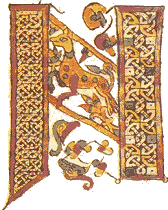
Gothic Design
Learn More.
| HOME Feature Articles Stone Carver's Tour Virtual Cathedral Cathedral Tours Gothic Field Guide GOTHIC GEOMETRY Virtual Abbey Medieval Art Tours Castle Tours Links Resources About The Site FAQ |
|
Saints' Lives - biographies of Christian role models canonized by the church and a widely popular genre from the early Middle Ages on. Scribe - a monk in a monastic Scriptorium who physically wrote text in a manuscript and was sometimes responsible for illumination and rubrication. Depending on time and place, distinctions in class varied as librarii, or apprentices, sometimes trained under the tutelage of antiquarii or senior scribes. Under this arrangement, the bibliothecarius, or librarian, might assume administrative duties.
Script - a term used for the constantly changing style of handwriting used in manuscripts that generally establishes a time period or location in which a manuscript was written; distinguished by majuscule (uppercase) and minuscule (lowercase) lettering; cursive (rapidly written) or formata (formal) and arguably falling into the following eras: Uncials 400-600; Insular minuscules 500-1000; Anglo-Saxon 600-1100; Carolingian minuscule 800-1200 Early Gothic ca. 1150; Late Gothic ca. 1400. Scriptorium - the place within the monastery where manuscripts were written. A typical Benedictine scriptorium included a large central table and writing desks placed along the walls. Another arrangement may have consisted of small individual writing rooms, or scriptoriolum and in some instances the cloister alcoves were screened off into writing chambers, or carrells. Underdrawing - the initial drawing laid down before ink or paint was applied. Completed in Hard Point in early scriptoria, and later in Lead Point. Vellum - See Parchment. Vernacular - the regional language, as opposed to the customary Latin used in a great many monastic manuscripts, first seen in Ireland and Britain as early as the 6th century. Zoomorphic
Initial - a decorated initial formed wholly or in part
from real or imaginary animals, as below:
|
Sponsored
Links
copyright © 2017

